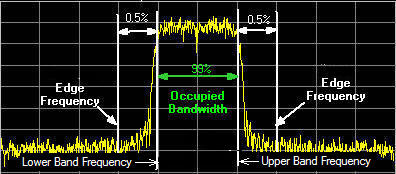
Last Updated: August 29, 2007
This topic describes the Occupied Bandwidth measurement. Occupied Bandwidth is a measurement in the Reverse Traffic Channel measurement suite.
As defined by C.S0033-A V1.0 section 4.4.3 and C.S0011-B V1.0 section 4.5.3, Occupied Bandwidth (OBW) is "the frequency range, whereby the power of emissions averaged over the frequency above and under the edge frequency are 0.5 % each of the total radiation power of a modulated carrier". The test set allows the percentage of total radiation power (which is referred to as Percent of Total Integrated Power) to be adjusted from 70.0 to 99.0%.
Figure 1: Occupied Bandwidth when Percentage of Total Integrated Power is set to 99%

First, when the total radiation power is set to 99% as shown in Figure 1, the total power found in the measured frequency range is calculated. During this measurement, a Gaussian filter with a resolution bandwidth (RBW) of 30 kHz or less is used to measure the distribution of the power spectrum in a measurement bandwidth greater or equal to 5 MHz.
Then, starting at the lowest frequency in the range and moving upward, the power distributed in each frequency is summed until this sum is 0.5% of the total power. This gives the lower frequency value. Next, starting at the highest frequency in the range and moving downward, the power distributed in each frequency is summed until 0.5% of the total power is reached. This gives the upper frequency value. The bandwidth between the 0.5% power frequency points is the occupied bandwidth.
The same process is used when the percentage of radiation power is set to a different value; however the low and high frequencies that determine the occupied bandwidth are determined by summing the power distributed in each frequency to a percentage that corresponds to what the Percent of Total Integrated Power is set to.
The measurement period used for this measurement is 1 power control group (1.25 ms) for a cdma2000 RTCH Channel Power measurement, and 1 slot (1.667 ms) for a 1xEV-DO RTCH Channel Power Power measurement.
Occupied Bandwidth is a measurement in the Reverse Traffic Channel measurement suite. See Reverse Traffic Channel Measurement Suite Measurement Parameters for details of the parameters that apply to measurements in the suite.
Occupied Bandwidth is a measurement in the Reverse Traffic Channel measurement suite. See Reverse Traffic Channel Measurement Suite Limits for details of the measurement limits that apply to measurements in the suite.
This result provides the integrity indicator for the Reverse Traffic Channel measurement suite. Normal indicates that the measurement suite completed successfully without error and the result is accurate. For details of other integrity indicators, see Measurement Integrity Indicator.
SCPI command: FETCh:CRTChannel:INTegrity?
The result indicates whether the Occupied Bandwidth measurement passes or fails.
SCPI commands: FETCh:CRTChannel:OBWidth[:PARTial]?, or FETCh:CRTChannel:OBWidth:ALL?
This result provides the bandwidth in MHz that contains the specified percentage of the total integrated power of the transmitted spectrum, centered on the assigned channel frequency. The Occupied Bandwidth is the Upper Band Frequency minus the Lower Band Frequency. If the Multi-Measurement Count is enabled, the average Occupied Bandwith result is returned, otherwise a single measurement result is returned.
SCPI command: FETCh:CRTChannel:OBWidth[:PARTial]?, or FETCh:CRTChannel:OBWidth:ALL?
This result provides the maximum occupied bandwidth in MHz measured during a multi-measurement. This result is not displayed on the front panel when the Multi-Measurement Count is Off.
SCPI command: FETCh:CRTChannel:OBWidth:ALL?
This result provides the minimum occupied bandwidth in MHz measured during a multi-measurement. This result is not displayed on the front panel when the Multi-Measurement Count is Off.
SCPI command: FETCh:CRTChannel:OBWidth:ALL?
This result provides the standard deviation of the occupied bandwidth in MHz measured during a multi-measurement. This result is not displayed on the front panel when the Multi-Measurement Count is Off.
SCPI command: FETCh:CRTChannel:OBWidth:ALL?
This result provides the frequency (in MHz), in the measured frequency range, that is the upper boundary for determining the occupied bandwidth. Only averaged results are returned when the Multi-Measurement Count is enabled. If the Normalize parameter is enabled, results are normalized to the expected frequency. Otherwise, absolute frequency results are returned. The occupied bandwidth is the difference between the Upper Band Frequency and Lower Band Frequency.
SCPI command: FETCh:CRTChannel:OBWidth:ALL?
This result provides the frequency (in MHz), in the measured frequency range, that is the lower boundary for determining the occupied bandwidth. Only averaged results are returned when the Multi-Measurement Count is enabled. If the Normalize parameter is enabled, results are Normalized to the expected frequency. Otherwise, absolute frequency results are returned.
SCPI command: FETCh:CRTChannel:OBWidth:ALL?
This result provides the center frequency in MHz in the measured frequency range. This result is the mean of the upper and lower band frequencies. Only averaged results are returned when the Multi-Measurement Count is enabled. If the Normalize parameter is enabled, results are Normalized to the expected frequency. Otherwise, absolute frequency results are returned.
SCPI command: FETCh:CRTChannel:OBWidth:ALL?
Occupied Bandwidth is a measurement in the Reverse Traffic Channel measurement suite. See Reverse Traffic Channel Input Signal Requirements for details of the input signal requirements that apply to all measurements in the suite.